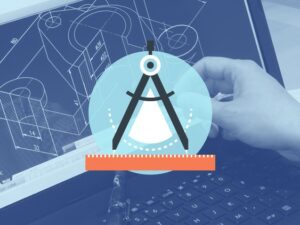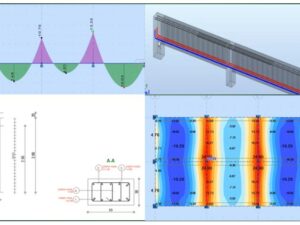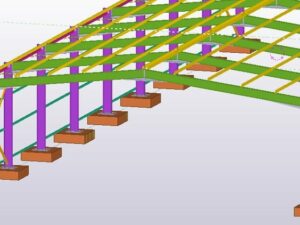ANSYS CFD: Mastering External Aerodynamics & Turbomachinery
- Description
- Curriculum
- FAQ
- Reviews

This course is one of the most practical and in-demand CFD training programs available online, designed to take your skills from beginner to expert in no time.
Whether you’re looking to start a career in computational fluid dynamics or level up your current skills, this course is tailored to teach Ansys CFD at a professional level. You’ll master how to solve real-world fluid dynamics challenges using CFD techniques, from the basics of geometry creation and meshing to advanced solution processing. By the end, you’ll be equipped with cutting-edge CFD skills in both external aerodynamics and turbomachinery, making you industry-ready.
We focus on hands-on learning, so you won’t just learn theory—you’ll dive deep into the full process of CFD simulation. You’ll learn how to extract critical data, build and clean geometries, and develop computational domains using top-tier software like SpaceClaim and DesignModeler. You’ll then take those geometries through advanced meshing with ICEMCFD and import them into Fluent or CFX to iteratively solve complex flow and heat transfer problems. You’ll also cover essential topics like selecting the right turbulence models, setting optimal Y+ values, and applying effective boundary conditions to enhance your simulations.
Once the solution phase is complete, you’ll learn how to post-process results, interpret them effectively, and compare them to real-world data—ensuring that you’re delivering the highest-quality CFD analysis, even when experimental data isn’t available.
Why choose this course?
-
Real-world projects: Apply what you’ve learned with actual engineering problems in external aerodynamics, turbomachinery, and much more.
-
Comprehensive learning: Go from zero to expert with step-by-step guidance on every part of the CFD process.
-
Stay up to date: We are upgrading all our workshops to ANSYS 2024 R2, with full implementation expected by the end of November 2024.
-
Exclusive content: The latest addition, “CFD Analysis of High-Speed Projectile,” was just added in October 2024 in Section 27.
Don’t miss out—join now to unlock the full potential of CFD with Ansys and take your engineering career to the next level!
-
9Introduction, opening ICEMCFD, Working directory and surface resolution
-
10Creating Parts for boundary conditions
Parts is important aspect of ICEM CFD mesh generation process. Parts will be used to create boundary conditions in Fluent or CFX.
-
11Mesh settings and volue mesh generation using Octree method
-
12Improving surface mesh quality using laplace smoothing
-
13Creating density boxes and delaunay mesh
-
14Problem Description
-
15Prism mesh generation and editing
-
16Mesh info and mesh export for Fluent and CFX
-
24Importing IGES file and applying some preliminary settings
-
25Moving file to origin, deleting interface region and creating lines
-
26Recreating important surfaces
-
27Separating different components and some processing
-
28Creating final model of scroll with extended region at outlet
-
29Creating final model of Inlet-Cone with extended region at inlet
-
30Creating final model of centrifugal fan impeller
-
31Introduction and file import into ICEMCFD
-
32Creating Tetra-Prism mesh for Inlet-Cone and export in fluent format with BCs
-
33Creating Tetra-Prism mesh for Volute/Scroll : Build topology and parts
-
34Creating Tetra-Prism mesh for Volute/Scroll : Mesh generation and export
-
35Creating Tetra-Prism mesh for centrifugal fan impeller
-
36Introduction and discussion about SRF and MRF
-
37When to use MRF?
-
38Setting up SRF model in Fluent
-
39Setting up Frozen Rotor model in Fluent and mesh interfaces
-
40Setting up mixing plane model in Fluent
-
41Setting up sliding mesh model in Fluent
-
42Boundary conditions for rotating and stationary domains
-
43Summary of different turbomachinery models in Fluent
-
44Difference between Frozen rotor, mixing plane and sliding mesh model
-
45Best practices for different type of simulation cases
-
46Launching fluent and Importing three domain mesh files using append command
-
47Setting up interfaces and Frozen Rotor model
-
48Turbulence model, near wall treatment, boundary layer and Y+
-
49Y+ contours for SST and K-Epsilon realizable model with scalable wall functions
-
50Boundary condition
-
51Solution methods & controls, residuals & monitors and solution
-
52Basic post processing of centrifugal fan : Contours, Vectors and Pathlines
-
53Generating Fan performance map - Advanced level post processing
-
54Creating solution animation
-
59Introduction
-
60Starting workbench and design modeler
-
613_Ahmed body Sketch with all dimensions
-
623D model generation using extrude command
-
63Adding 4 legs using extrude and pattern commands
-
64Round, unite and rotate body to required location
-
65Creating domain for Ahmed body, symmetric model and removal of legs
-
66Creating named selection for boundary conditions
-
67Project and geometry open, save in different formats
-
71Introduction
-
72Y+, First cell height, and Y+ calculator in excel
-
73Discussion on hybrid wall functions by Knopp
-
74Boundary layer, first cell height and Yplus on Ahmed body
-
75Geometry import and creation of parts
-
76Global Mesh Size and Size function
-
77Setting mesh sizes on parts
-
78Creating density box for local mesh refinement in wake region
-
79Computing volume mesh using two methods and surface mesh smoothing
-
80Generating boundary layer mesh using prisms
-
81Mesh export and creating three meshes for mesh independence
-
82Problem setup in Fluent along with reference conditions
In this video you will learn about the different options in Fluent, how to setup working directory, double precision solver, parallel processing, pressure based solver, turbulence models, boundary conditions and reference conditions.
I have also discussed about the availability of various meshes for this case.
-
83Solving case in Fluent with optimum settings






Social Network